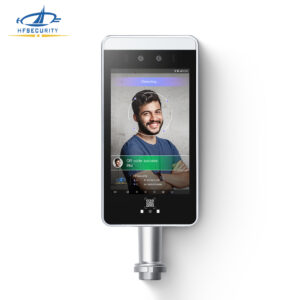This is the heading
How Face Scanners Work
Face scanners use advanced algorithms and AI-powered cameras to analyze the unique features of a person’s face, such as the distance between the eyes, nose shape, jawline, and skin texture. Modern systems often integrate 3D face mapping, infrared imaging, and liveness detection to prevent spoofing with photos or masks.
Key Steps in Face Scanning
1. Detection – Locating the Face in Real Time
In the first step, the face recognition system uses advanced algorithms to detect and locate a human face within the camera frame. This may involve 3D depth sensors, infrared imaging, or AI-based facial detection models. The goal is to accurately distinguish a real human face from the background, even under various lighting conditions or angles. This step also includes liveness detection to ensure that the input is not a photo, video replay, or mask.
2. Capture – Collecting High-Quality Facial Data
Once the system detects a face, it captures high-resolution facial features, such as the spacing of the eyes, the shape of the nose, jawline structure, and other biometric facial landmarks. Depending on device capabilities, the system may also capture depth information and skin texture patterns to enhance accuracy and security. This stage ensures that the collected image or facial data is clear, stable, and suitable for analysis.
3. Analysis – Generating a Digital Facial Template
After capturing the face, the system processes the data using AI facial recognition algorithms to extract unique identifiers. These unique identifiers are converted into a mathematical representation, often referred to as a biometric facial template. Instead of storing an actual photo, the system stores this encrypted digital model, which enhances privacy and data protection. The more precise the algorithm, the higher the recognition accuracy.
4. Matching – Verifying Identity Against Stored Records
In the final step, the newly generated facial template is compared against pre-registered templates stored in the database (local server, cloud system, or device memory). If the similarity score reaches the required threshold, the system confirms the user’s identity. This is known as 1:1 verification (comparing one face to one identity) or 1:N identification (comparing one face to a large database of users). The result triggers the intended action, such as door access, attendance logging, or payment authorization.
Pros of Using a Face Scanner
1. High Convenience and Speed
Face scanners allow for contactless verification, which speeds up entry and reduces queues in workplaces, gyms, airports, and secure facilities.
2. Enhanced Security
With advanced AI algorithms and anti-spoofing technologies, face scanners offer reliable authentication. Liveness detection ensures that masks, photos, or videos cannot trick the system.
3. Non-Intrusive and Hygienic
Unlike fingerprint scanners or PIN systems, face scanners are completely contactless, making them ideal for environments where hygiene is important.
4. Versatile Integration
Face scanners can integrate with access control, time attendance systems, mobile devices, and even payment platforms, creating a seamless experience for users and administrators.
5. Difficult to Forge
Unlike passwords or ID cards, facial features are unique to each individual, making it extremely difficult for unauthorized users to gain access.
Cons of Using a Face Scanner
1. Privacy Concerns
The collection and storage of biometric data can raise privacy issues. Organizations must comply with regulations like GDPR to protect user information.
2. False Positives / Negatives
Although highly accurate, some face scanners may occasionally fail to recognize authorized users or mistakenly grant access to unauthorized individuals, especially under poor lighting or if the user’s appearance changes significantly.
3. Environmental Limitations
Face scanners may be affected by lighting conditions, camera angle, or facial obstructions such as sunglasses or masks. Advanced systems with infrared and 3D mapping mitigate these issues but at a higher cost.
4. Higher Initial Costs
Compared to traditional access control methods, deploying a face scanner system can require a significant investment in hardware and software.
Applications of Face Scanners
Face scanners are widely used in multiple industries due to their security, convenience, and efficiency:
| 애플리케이션 | 목적 | Example |
|---|---|---|
| Corporate Offices | Access control and employee attendance | Employees enter with face verification, replacing ID cards |
| Airports | Passenger identification and security screening | Fast boarding and identity verification |
| 금융 서비스 | Banking and payment authentication | Secure mobile payments with facial recognition |
| 헬스케어 | Patient verification | Prevent medical record errors and unauthorized access |
| Events and Venues | Ticketless entry | Contactless check-in for concerts and conferences |
Tips for Ensuring Maximum Security
Use face scanners with liveness detection to prevent spoofing.
Regularly update the software and firmware to maintain security.
Encrypt facial templates to protect stored biometric data.
Combine face scanners with multi-factor authentication for sensitive areas.
결론
Face scanners are a secure and efficient biometric solution for modern security needs. While there are some privacy and environmental limitations, the pros—including convenience, speed, and advanced anti-spoofing—often outweigh the cons. For businesses and institutions looking for reliable access control and time attendance solutions, face scanners are a practical choice.
문의하기
We would love to speak with you.
Feel free to reach out using the below details.



